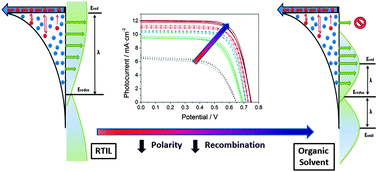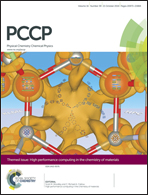Control of the recombination rate by changing the polarity of the electrolyte in dye-sensitized solar cells†
Abstract
Recombination in Dye-sensitized Solar Cells (DSCs) is an electron transfer process critical for high efficiency. The chemical nature of the electron acceptor is known to have an important impact on recombination and, hence, limits the choice of hole conductors in DSCs and related solar cells. In this respect, Room Temperature Ionic liquids (RTILs) have been recognized as an alternative to volatile organic solvents due to their negligible vapor pressure, which offers the chance for long-term stability. However, RTIL-based electrolytes lead to lower performance, a feature that has been attributed to the high viscosity of ionic liquids and the mass-transport limitation associated with it. In this work we show that the origin of the lower performance is also related to an increase in the recombination loss due to the polar nature of the RTIL and the influence of the reorganization energy of the electron acceptor in a polar environment. To investigate this chemical effect, different mixing ratios of RTILs and an organic solvent (acetonitrile) have been considered. The fabricated devices have been characterized by small-perturbation techniques (Impedance Electrochemical Spectroscopy and Intensity-Modulated Photovoltage and Photocurrent Spectroscopies) and Open-Circuit Voltage Decay measurements, which have been used to extract electron lifetimes at different applied voltages. Two different ruthenium dyes (hydrophilic N719 and hydrophobic Z907) and two different cations in the RTIL (imidazolium- and pyrrolidinium-based) have been considered. The results obtained show that for pure ionic liquids the lifetime–voltage curve is exponential, which is a signature of large reorganization energies for electron transfer. In contrast, pure acetonitrile exhibits a non-exponential behavior, which is consistent with relatively low reorganization energy. Interestingly, and as a general rule, we find that recombination is faster in systems with higher reorganization energies. This is interpreted as a consequence of the availability of more acceptor states for electron transfer. In addition, it is found that mixing RTILs and acetonitrile is an interesting strategy to increase the stability of DSCs without significant recombination losses, provided that the right dye and RTIL, in particular, a pyrrolidinium component, are used.


 Please wait while we load your content...
Please wait while we load your content...